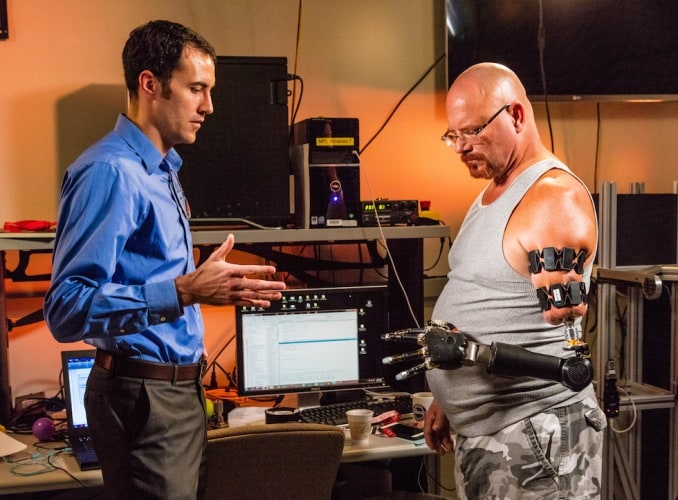The MPL was developed by the Johns Hopkins University Applied Physics Laboratory (APL) and the procedure represents a first for the field of prosthetics.
“This accomplishment has eliminated one of the biggest gaps in prosthetic development: the socket,” said Michael McLoughlin, chief engineer in APL’s Research and Exploratory Development Department.

The socket - the part of the prosthesis that attaches to the body - is the most critical component of prosthesis because if it does not fit correctly, the patient can experience pain, sores and blisters, and the prosthesis will feel heavy and cumbersome, said APL’s Courtney Moran, a clinical prosthetist.
“The sling does get a little uncomfortable after working with the MPL [Modular Prosthetic Limb] for a while,” said Johnny Matheny, one of several patients who have worked with the MPL over the years to help scientists, engineers and physicians fine tune its capabilities.
Matheny was the first patient at the Johns Hopkins Hospital to undergo targeted muscle reinnervation (TMR), a surgical procedure that reassigns nerves that once controlled the arm or hand, which can make it possible for upper-extremity amputees to better use and control an advanced prosthetic device.
The procedure to mount the prosthetic arm directly to his residual limb is called osseointegration. The first stage of the process requires a threaded titanium implant - a fixture – to be inserted into the marrow space of the bone of the residual limb. Over time, the fixture becomes part of the bone. Several weeks after the first surgery, a titanium extension known - an abutment - is attached to the fixture and brought out through the soft tissues and skin. The prosthesis can then be directly attached to the abutment.
Richard McGough, chief of the Division of Musculoskeletal Oncology at the University of Pittsburgh Medical Center, performed the stage one surgery on Matheny in March 2015 and stage two in June 2015, making Matheny the first patient in the United States to receive the TMR and osseointegration. Four months later, Matheny travelled to APL and attached the MPL directly to his body for the first time.
“Before, the only way I could put the prosthetic on was by this harness with suction and straps; but now, with osseointegration, the implant does away with all that,” said Matheny. “It’s all natural now. Nothing is holding me down. Before, I had limited range; I couldn’t reach over my head and behind my back. Now…that limitation is gone.”
During tests at APL’s prosthetics laboratory Matheny was able to demonstrate individual finger control, simultaneous finger control, two degrees of freedom at the wrist, and multiple grasps, and he worked through simulated activities of daily living.
“The challenge for us next is to really figure out how to get this technology out of the laboratory and into the hands of people that need it,” said McLoughlin. “Unless that technology gets in the hands of the injured war fighter, the elderly person who’s having trouble living independently, unless that happens, we haven’t really fulfilled our mission.”




JLR teams with Allye Energy on portable battery storage
This illustrates the lengths required to operate electric vehicles in some circumstances. It is just as well few electric Range Rovers will go off...